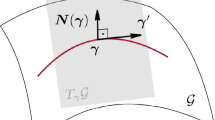Abstract
Recent studies have shown that the constant inertia assumption made in typical muscle dynamic models can lead to significant discrepancies in accuracy of simulation or inverse dynamics. This paper proposes a general framework for musculoskeletal dynamic simulation that takes into account changes in muscle inertia that occur during movement. We first develop a general shape-varying muscle mass model in which muscle deformations are modeled via linear volume-preserving transformations, and derive a corresponding muscle mass matrix and Jacobian in a Lagrangian setting. A dynamic musculoskeletal model is then constructed, in which each muscle is segmented into multiple segments that are each modeled using our earlier muscle deformation model. Depending on the extent of muscle segmentation, the musculoskeletal dynamics can be simulated to arbitrary resolution. To improve the computational efficiency of the simulation, we propose a spline-based dynamics algorithm consisting of an offline and online computation stage. In the offline stage, a parametrized B-spline surface on the space \(\mathcal{P}(n)\) of n×n symmetric positive-definite matrices is constructed so as to fit a set of sampled values of the system mass matrix. In the online computation stage, given an arbitrary configuration, the mass matrix for that configuration is obtained as a weighted average of the nearest sampled values (i.e., the control points of the B-spline surface). The Coriolis forces are evaluated directly from the partial derivatives of the B-spline approximation of the mass matrix. Our method ensures that the online computational costs effectively remain fixed independently of the system dimension or complexity. Detailed case studies involving planar arms with multiple shape-varying muscles attached demonstrate the feasibility and computational advantages of our proposed method for musculoskeletal modeling and simulation.
















Similar content being viewed by others
References
Chadwick, J.E., Haumann, D.R., Parent, R.E.: Layered construction for deformable animated characters. In: ACM Siggraph Computer Graphics, vol. 23, pp. 243–252. ACM, New York (1989)
Sederberg, T.W., Parry, S.R.: Free-form deformation of solid geometric models. In: ACM Siggraph Computer Graphics, vol. 20, pp. 151–160. ACM, New York (1986)
Moccozet, L., Thalmann, N.M.: Dirichlet free-form deformations and their application to hand simulation. In: Computer Animation’97, pp. 93–102. IEEE, New York (1997)
Nedel, L.P., Thalmann, D.: Real time muscle deformations using mass–spring systems. In: Computer Graphics International, 1998. Proceedings, pp. 156–165. IEEE, New York (1998)
Chen, D.T., Zeltzer, D.: Pump it up: Computer animation of a biomechanically based model of muscle using the finite element method, vol. 26. ACM, New York (1992)
Zhu, Q.-h., Chen, Y., Kaufman, A.: Real-time biomechanically-based muscle volume deformation using FEM. In: Computer Graphics Forum, vol. 17, pp. 275–284 (1998), Wiley Online Library
Teran, J., Blemker, S., Hing, V., Fedkiw, R.: Finite volume methods for the simulation of skeletal muscle. In: Proceedings of the 2003 ACM SIGGRAPH/Eurographics symposium on Computer animation, pp. 68–74, Eurographics Association, Aire-la-Ville (2003)
Millard, M., Uchida, T., Seth, A., Delp, S.L.: Flexing computational muscle: Modeling and simulation of musculotendon dynamics. J. Biomech. Eng. 135(2), 021005 (2013)
Millard, M., Delp, S.: A computationally efficient muscle model. In: ASME 2012 Summer Bioengineering Conference, pp. 1055–1056. American Society of Mechanical Engineers, New York (2012)
Lee, D., Glueck, M., Khan, A., Fiume, E., Jackson, K.: Modeling and simulation of skeletal muscle for computer graphics: A survey. Found. Trends Comput. Graph. Vis. 7(4), 229–276 (2012)
Pai, D.K.: Muscle mass in musculoskeletal models. J. Biomech. 43(11), 2093–2098 (2010)
Rao, G., Amarantini, D., Berton, E., Favier, D.: Influence of body segments’ parameters estimation models on inverse dynamics solutions during gait. J. Biomech. 39(8), 1531–1536 (2006)
Piovesan, D., Pierobon, A., DiZio, P., Lackner, J.R.: Comparative analysis of methods for estimating arm segment parameters and joint torques from inverse dynamics. J. Biomech. Eng. 133(3), 031003 (2011)
Abbott, B., Baskin, R.: Volume changes in frog muscle during contraction. J. Physiol. 161(3), 379–391 (1962)
Matsubara, I., Elliott, G.F.: X-ray diffraction studies on skinned single fibres of frog skeletal muscle. J. Mol. Biol. 72(3), 657–669 (1972)
Alperin, J., Bell, R.: Groups and representations. Graduate texts in mathematics (1995)
Müller, A., Maisser, P.: A Lie-group formulation of kinematics and dynamics of constrained mbs and its application to analytical mechanics. Multibody Syst. Dyn. 9(4), 311–352 (2003)
Fletcher, P.T., Joshi, S.: Riemannian geometry for the statistical analysis of diffusion tensor data. Signal Process. 87(2), 250–262 (2007)
Smith, S.T.: Covariance, subspace, and intrinsic Cramer–Rao bounds. IEEE Trans. Signal Process. 53(5), 1610–1630 (2005)
Dryden, I.L., Koloydenko, A., Zhou, D.: Non-Euclidean statistics for covariance matrices, with applications to diffusion tensor imaging. Ann. Appl. Stat. 3(3), 1102–1123 (2009)
Barmpoutis, A., Vemuri, B.C., Shepherd, T.M., Forder, J.R.: Tensor splines for interpolation and approximation of DT-MRI with applications to segmentation of isolated rat hippocampi. IEEE Trans. Med. Imaging 26(11), 1537–1546 (2007)
Nakamura, Y., Dasgupta, A.: Generation of physically consistent interpolant motion from key frames for human-like multibody systems in flight. In: Intelligent Robots and Systems. IROS’99. Proceedings. 1999 IEEE/RSJ International Conference on, vol. 2, pp. 1102–1107. IEEE, New York (1999)
Martin, B.J., Bobrow, J.E.: Determination of minimum-effort motions for general open chains. In: Robotics and Automation. Proceedings, 1995 IEEE International Conference on, vol. 1, pp. 1160–1165. IEEE, New York (1995)
Kim, J., Baek, J., Park, F.C.: Newton-type algorithms for robot motion optimization. In: Intelligent Robots and Systems. IROS’99. Proceedings. 1999 IEEE/RSJ International Conference on, vol. 3, pp. 1842–1847. IEEE, New York (1999)
Lee, S., Choi, M., Kim, H., Park, F.C.: Geometric direct search algorithms for image registration. IEEE Trans. Image Process. 16(9), 2215–2224 (2007)
Holden, M.: A review of geometric transformations for nonrigid body registration. IEEE Trans. Med. Imaging 27(1), 111–128 (2008)
Acknowledgements
This research was supported in part by the ADD Biomimetic Robotics Research Center, the Center for Advanced Intelligent Manipulation, SNU-IAMD and BK21+ program in mechanical engineering at Seoul National University.
Author information
Authors and Affiliations
Corresponding author
Rights and permissions
About this article
Cite this article
Han, M., Hong, J. & Park, F.C. Musculoskeletal dynamics simulation using shape-varying muscle mass models. Multibody Syst Dyn 33, 367–388 (2015). https://doi.org/10.1007/s11044-014-9427-6
Received:
Accepted:
Published:
Issue Date:
DOI: https://doi.org/10.1007/s11044-014-9427-6




